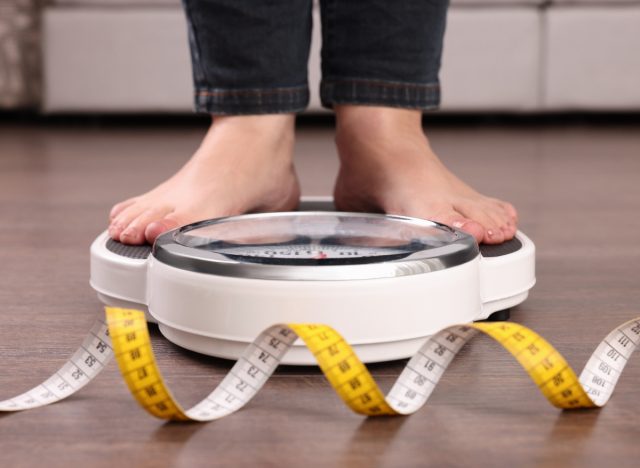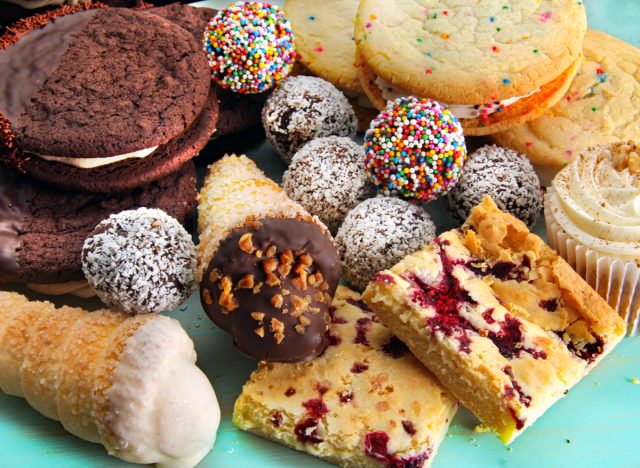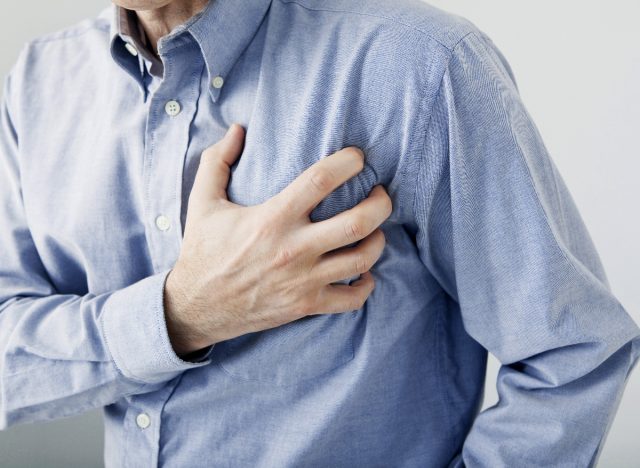Before you can truly understand what happens to your body when you eat bleached flour, you have to know what bleached flour is and what foods you’ll find it in. This fine white flour is the main ingredient in many foods, such as bread, pancakes, waffles, breakfast cereals, crackers, pasta, pastries, and cakes.
Bleached flour, as the name suggests, is bleached white. But first, it is refined, meaning the wheat grain it started as has been completely stripped of the nutrient-rich bran and germ of the wheat kernel, leaving just the softer endosperm. “The refining process results in less protein, less fiber, and less of some vitamins and minerals than its whole grain counterpart,” says Eat This, Not That! medical review board member Molly Hembree, MS, RD, LD, a registered dietitian.
After refining, the milled flour is bleached by grain millers by treating the flour with chemicals like chlorine gas or benzoyl peroxide. The end product is a bright white flour that’s super fine and velvety soft, ideal for producing delicate baked goods.
Although a household staple, bleached flour is not the best choice of flour when it comes to your health. “Choosing foods made with refined flour regularly not only causes you to miss out on important nutrition, but it can set you up for lower satiety and poorer control of blood sugars,” explains Hembree. That’s why foods made from whole grains are advised; they contain the most nutrients, including dietary fiber which minimizes the impact of carbohydrates on blood sugar. “Opt for 100% whole grains for at least half of all grain choices made daily,” Hembree advises.
Over time, consuming a lot of simple sugars—like those in bleached flour products—can make your insulin response less effective, requiring your pancreas to pump out more insulin, which is a hormone that shuttles sugar (glucose) into your cells where it can be used as fuel. This can cause insulin resistance where your insulin becomes less effective at moving glucose into your cells, so it builds up in your blood. That can lead to health problems like the following. Read on to find out more, and for more on how to eat healthy, don’t miss The #1 Best Juice to Drink Every Day, Says Science.


Type 2 diabetes mellitus is a chronic disease characterized by insulin resistance, resulting in very high levels of sugar in the bloodstream. While genetics, race and ethnic background, and your age play a role, lifestyle is a major contributor to type 2 diabetes so the disorder can be reversed through diet and exercise. Thirty-seven million Americans have type 2 diabetes and an estimated 96 million have pre-diabetes, the precursor to the disease, according to the CDC’s National Diabetes Statistics Report. Type 2 diabetes is a serious disorder that can lead to blindness, nerve damage, kidney disease, heart attack, and stroke.


Obesity is another sign and symptom of high blood sugar and poor insulin sensitivity often from eating too many bleached flour products. When foods lack fiber, they don’t satisfy your hunger for very long, so you end up wanting to eat more and more. This is a huge conundrum for anyone trying to lose weight—and it shines a spotlight on the solution: Don’t eat refined flour; get more fiber. Dietary fiber slows down digestion, the breakdown of food into glucose, so you feel fuller for longer after eating. Clinical research, like this study in Nutrition, shows strong evidence for fiber’s ability to foster weight loss and weight maintenance.
READ RELATED: Sam Neill health: Star, 74, on the 'darkness' of his 'terrible' mental health


We’ve all experienced it, some worse than others. And if it occurs regularly, it can literally become a pain in the ass—hemorrhoids and anal fissures are common side effects. While there can be many causes of getting backed up, some requiring a doctor’s diagnosis and help, often it’s a result of a lack of dietary fiber. Maybe you’re eating too many foods devoid of fiber like those made with refined bleached flour.
Dietary fiber is essential to keep your digestive tract running as it should and keep you pooping properly without needing to push. Studies show that high-energy-content foods and sugary products low in fiber and high in sodium are associated with higher rates of constipation. If you’re eating too many simple carbs, start getting more fiber into your meals, but do it slowly and drink lots of water to keep stools soft and moving smoothly.


Dietitians tell us all the time: Eating white bread, cakes, cookies, cereal, and pasta from refined grains and white rice does more than raise your blood sugar quickly—it also tends to replace healthier foods. If you are snacking on crackers and brownies, you’re probably not snacking on apples, grapes, and carrot sticks. If you’re having a roll of bread with your spaghetti noodles that are not made from lentil flour or whole-grain flour, you’re probably hungry for dessert shortly after you’ve finished your meal. When you eat a lot of bleached flour products, you effectively elbow out a lot of the nutritious, whole foods you should be eating.


Officially called “chronic low-grade inflammation,” it’s when your immune system is in a constant, long-term state of alert, pumping out immune system chemicals that over time can damage cells. “Chronic inflammation can cause weight gain, skin problems, digestive issues, and a host of diseases, including diabetes, cancer, depression, and heart disease,” says Mike Zimmerman, author of our book The 14-Day Anti-Inflammatory Diet. Several studies have suggested that a high intake of carbohydrates, especially those from foods with a high glycemic index like cakes, cookies, pasta, and other bleached flour products, is associated with high concentrations of pro-inflammatory immune system compounds.


Cardiovascular disease, heart attack, and heart failure are all tied to the metabolic disorders—inflammation, high blood sugar, diabetes, and obesity. In 2017, an article published in The Lancet presented evidence showing that eating a lot of refined grain products is associated with higher mortality from CVD while consuming fats was not. A few years earlier, a meta-analysis in The BMJ demonstrated that people who ate the most fiber had the lowest risk of coronary heart disease. The BMJ study found that every 7 grams of additional fiber eaten daily reduced CVD risk by 9%.
So, the evidence continues to mount: Eating foods high in dietary fiber has many positive effects on your body while bleached flour foods devoid of healthy fiber and nutrients offer few if any benefits other than satisfying your sweet tooth. Hungry? Check out these Popular Foods With More Fiber Than Oatmeal.
Source:










